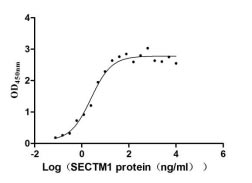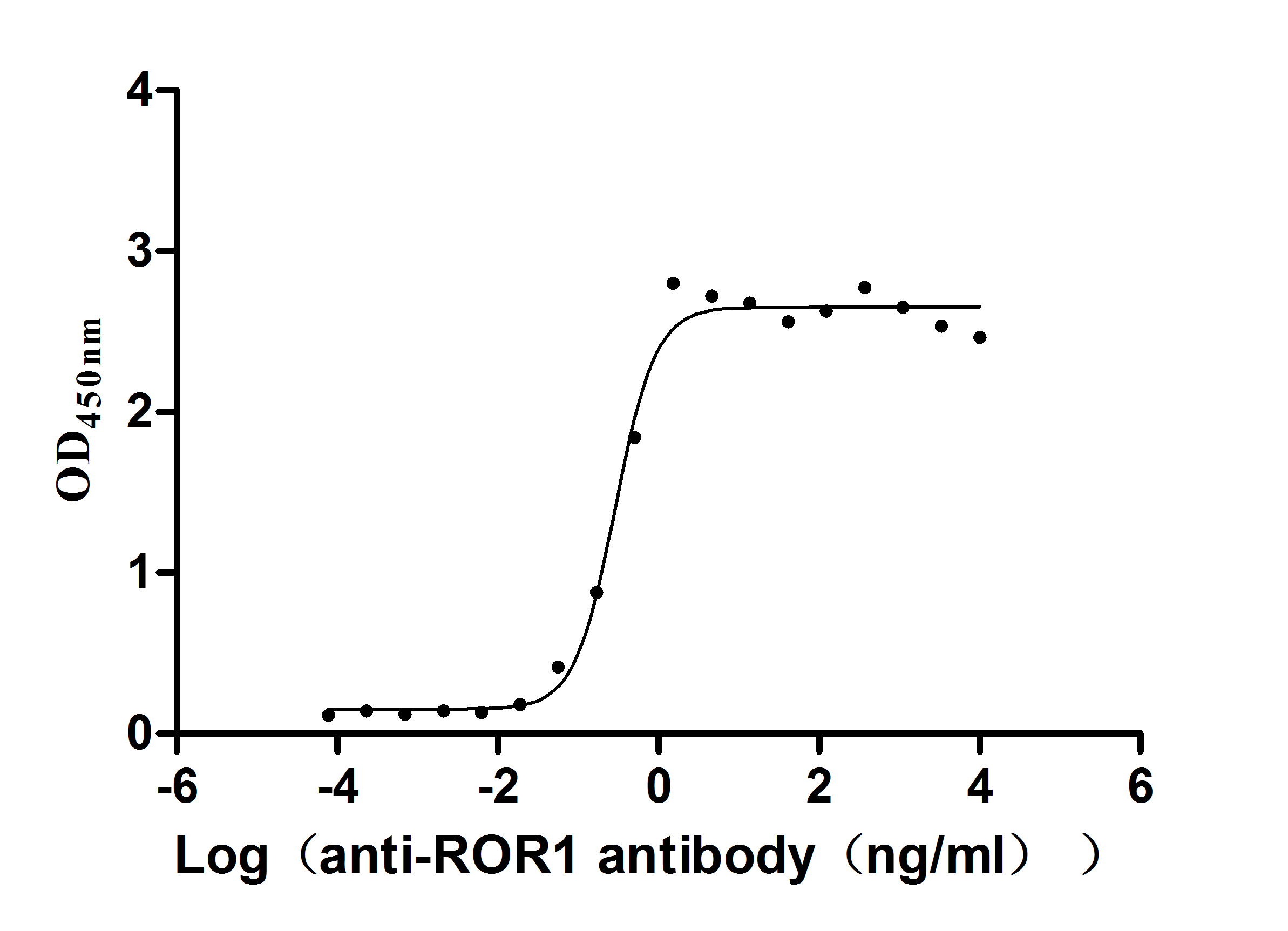Recombinant Mouse Fractalkine (Cx3cl1)
-
货号:CSB-CF006235MO
-
规格:
-
来源:in vitro E.coli expression system
-
其他:
产品详情
-
基因名:
-
Uniprot No.:
-
别名:Cx3cl1; Cx3c; Fkn; Scyd1; Fractalkine; FK; C-X3-C motif chemokine 1; CX3C membrane-anchored chemokine; Neurotactin; Small-inducible cytokine D1
-
种属:Mus musculus (Mouse)
-
蛋白长度:Full Length of Mature Protein
-
表达区域:25-395
-
氨基酸序列QHLGMTKCEIMCDKMTSRIPVALLIRYQLNQESCGKRAIVLETTQHRRFCADPKEKWVQDAMKHLDHQAAALTKNGGKFEKRVDNVTPGITLATRGLSPSALTKPESATLEDLALELTTISQEARGTMGTSQEPPAAVTGSSLSTSEAQDAGLTAKPQSIGSFEAADISTTVWPSPAVYQSGSSSWAEEKATESPSTTAPSPQVSTTSPSTPEENVGSEGQPPWVQGQDLSPEKSLGSEEINPVHTDNFQERGPGNTVHPSVAPISSEETPSPELVASGSQAPKIEEPIHATADPQKLSVLITPVPDTQAATRRQAVGLLAFLGLLFCLGVAMFAYQSLQGCPRKMAGEMVEGLRYVPRSCGSNSYVLVPV
Note: The complete sequence including tag sequence, target protein sequence and linker sequence could be provided upon request. -
蛋白标签:N-terminal 10xHis-tagged
-
产品提供形式:Liquid or Lyophilized powder
Note: We will preferentially ship the format that we have in stock, however, if you have any special requirement for the format, please remark your requirement when placing the order, we will prepare according to your demand. -
缓冲液:Lyophilized from Tris/PBS-based buffer, 6% Trehalose, pH 8.0
-
储存条件:Store at -20°C/-80°C upon receipt, aliquoting is necessary for mutiple use. Avoid repeated freeze-thaw cycles.
-
保质期:The shelf life is related to many factors, storage state, buffer ingredients, storage temperature and the stability of the protein itself.
Generally, the shelf life of liquid form is 6 months at -20°C/-80°C. The shelf life of lyophilized form is 12 months at -20°C/-80°C. -
货期:Basically, we can dispatch the products out in 1-3 working days after receiving your orders. Delivery time may differ from different purchasing way or location, please kindly consult your local distributors for specific delivery time.Note: All of our proteins are default shipped with normal blue ice packs, if you request to ship with dry ice, please communicate with us in advance and extra fees will be charged.
-
注意事项:Repeated freezing and thawing is not recommended. Store working aliquots at 4°C for up to one week.
-
Datasheet & COA:Please contact us to get it.
相关产品
靶点详情
-
功能:Chemokine that acts as a ligand for both CX3CR1 and integrins ITGAV:ITGB3 and ITGA4:ITGB1. The CX3CR1-CX3CL1 signaling exerts distinct functions in different tissue compartments, such as immune response, inflammation, cell adhesion and chemotaxis. Regulates leukocyte adhesion and migration processes at the endothelium. Can activate integrins in both a CX3CR1-dependent and CX3CR1-independent manner. In the presence of CX3CR1, activates integrins by binding to the classical ligand-binding site (site 1) in integrins. In the absence of CX3CR1, binds to a second site (site 2) in integrins which is distinct from site 1 and enhances the binding of other integrin ligands to site 1.; The soluble form is chemotactic for T-cells and monocytes, but not for neutrophils.; The membrane-bound form promotes adhesion of those leukocytes to endothelial cells.
-
基因功能参考文献:
- The data of this study suggested that overexpression of only chemokine domain of CX3CL1 does not protect against tau pathology. PMID: 30253780
- the CX3CL1/CX3CR1 axis contributes to the proliferative and pro-inflammatory effects of Ang II in VSMCs. PMID: 29356931
- that CX3CL1-CX3CR1 signaling is a molecular mechanism capable of modulating microglial-mediated degeneration PMID: 27314452
- CXCR4(+) CD45(-) bone marrow cells are niche forming for osteoclastogenesis via the SDF-1, CXCL7, and CX3CL1 signaling pathways in bone marrow. PMID: 27339271
- Increased fractalkine and its receptor CX3CR1 may cause a cross-talk between activated glial cells and neurons, playing an important role in the development of neuroinflammation in fructose-fed mice. PMID: 26765996
- miR-223 controls the expression of CX3CL1 by targeting HDAC2 in chronic obstructive pulmonary disease patients and mouse models of the disease. PMID: 26864305
- in this study, CX3CL1 is identified as a novel substrate of MMP-19 PMID: 26555704
- The CX3CL1/CX3CR1 system is essential for restricting coxsackievirus B3-induced myocarditis. PMID: 28800592
- changes in GSK-3beta activity and/or levels regulate the production and subsequent secretion of fractalkine, a chemokine involved in the immune response that has been linked to AD and to other different neurological disorders. PMID: 27832289
- Medial ganglionic eminence (MGE) interneurons secrete fractalkine that promotes genesis of oligodendrocytes from glially biased cortical precursors in culture. Moreover, when MGE interneurons are genetically ablated in vivo prior to their migration, this causes a deficit in cortical oligodendrogenesis. PMID: 28472653
- our findings reveal a previously unknown regulatory role for LRRK2 in CX3CR1 signalling and suggest that an increase of CX3CR1 activity contributes to the attenuated inflammatory responses in Lrrk2-null microglia PMID: 27378696
- a crucial role of CX3CL1-CX3CR1 in experimental colitis, in particular for intestinal leukocyte recruitment during murine colitis, is reported. PMID: 27942903
- These results strongly suggest the involvement of CX3CL1 in the migration of osteoclast precursors and osteoclastogenesis. PMID: 27579490
- s provide evidence that interactions between CX3CL1 and CX3CR1 play crucial roles in determining the number of M1 macrophages within the skin of mice, which in turn can have dramatic effects on psoriasis-like inflammation. PMID: 26976687
- In the absence of the rd8 allele, deficiency of CCR2 and CX3CL1 in mice leads to a mild form of retinal degeneration which is associated with the recruitment of macrophages, particularly to the subretinal space. This model enables to assess consequences of perturbed chemokine signaling, but it does not recapitulate cardinal age-related macular degeneration features. PMID: 26670885
- Also icariin reduced CX3CR1 and CX3CL1 protein levels in the artery wall. In conclusion, icariin could be a potential anti-atherosclerosis agent by downregulating the expression of CX3CR1. PMID: 26802470
- The biological activity of CX3CL1 is regulated by conversion of a membrane integrated to a soluble form during neurogenesis and in response to pathologic changes in the adult retinal milieu. PMID: 25191897
- CX3CL1/CX3CR1 signaling is involved in LTP of C-fiber-evoked field potentials in the rodent spinal dorsal horn PMID: 25768734
- CX3CL1/CX3CR1-mediated microglial activation plays a detrimental role in ischemic brain via p38MAPK/PKC signaling PMID: 25966946
- Cx3cl1 overexpression suppresses alpha-synuclein-mediated neurodegeneration. PMID: 25195598
- IFN-gamma induces aberrant CD49b+ NK cell recruitment and pregnancy failure through regulating CX3CL1. PMID: 25375377
- Insulin resistance increases plaque vulnerability by augmenting the CX3CL1/CX3CR1 axis, which is mechanistically linked to reduced vascular smooth muscle cell survival PMID: 24788416
- Together, these studies challenge the "frustrated phagocytosis" concept and suggest that neuronal-microglial communication link the two central AD pathologies. PMID: 25209291
- CX3CL1 may contribute to the regulation of toxigenic C. difficile infection. PMID: 24362517
- These results demonstrate that the de novo CX3CL1-CX3CR1 axis plays a pivotal role in osteoclast recruitment and subsequent bone resorption PMID: 24401612
- our data suggest that the CX3CR1/ CX3CL1 pathway is involved in the recruitment of circulating CD16 thorn CX3CR1 thorn monocytes to the periprosthetic tissues. PMID: 24700421
- Data indicate that atopic dermatitis (AD) pathology and immune responses were profoundly decreased in CX3CR1-deficient mice and upon blocking CX3CL1-CX3CR1 interactions in wild-type mice. PMID: 24821910
- Loss of ACE2 exacerbates AngII-mediated inflammation, myocardial injury and dysfunction in ACE2-deficient hearts via activation of the CTGF-FKN-ERK and MMP signaling. PMID: 24161906
- CX3CL1 transiently potentiates NMDAR function though mechanisms involving A2AR activity and the release of D-serine. PMID: 23981568
- Interactions between CX3CL1 and CX3CR1 may contribute to the development of leukocytoclastic vasculitis. PMID: 23470165
- HDACs and NF-kB signaling coordinate epithelial expression of CX3CL1 to promote mucosal antimicrobial defense through suppression of the mir-424-503 gene. PMID: 23724129
- carotid artery injury was associated with greater chemokine 1 CX3C expression in the acute phase followed by greater CX3C receptor 1 coexpressing smooth muscle-like cell content in later lesions and less neointima formation than in femoral arteries PMID: 23653073
- our data indicate an upregulation of fractalkine and downregulation of CX3CR1 in sepsis, which seems to be mediated by the transcripting factor NF-KappaB likely via reduced liberation of proinflammtory cytokines in the whole murine organism. PMID: 23026294
- Extracellular adenosine is an endogenous modulator of neuroinflammation that induces CX3CL1 at the chorid plexus. PMID: 22883932
- Fractalkine's essential role in the formation of atherosclerotic lesions and atherosclerosis progression has been impressively described in mouse models. Review. PMID: 22739755
- Suggest that Ang-II induces functional CX(3)CL1 expression in arterial but not in venous endothelial cells. PMID: 23117657
- H(2)S hampers the progression of atherosclerosis in fat-fed apoE(-/-) mice and downregulates CX3CR1 and CX3CL1 expression on macrophages and in lesion plaques PMID: 22815945
- Hypoxic release of endothelial CX3CL1 induced SMC phenotypic switching from the contractile to the proliferative state. Inhibition of CX3CR1 prevented CX3CL1 stimulation of SMC proliferation and monolayer expansion. PMID: 23002075
- Fractalkine is expressed in early and advanced atherosclerotic lesions and supports monocyte recruitment via CX3CR1. PMID: 22916279
- Fractalkine induced cellular reactive oxygen species production and activation of ERK1/2 and p38 MAPK in mesangial cells, stimulating cell proliferation. PMID: 22564616
- Lipopolysaccharide induces monocyte-mesangial cell binding through the fractalkine/CX3CR1 system. PMID: 22564617
- findings that exogenous fractalkine reduces microglial motility and fails to protect neurons co-cultured with Cx3cr1-/- mixed glia suggest that fractalkine may act by interfering with toxic microglial-neuron interactions PMID: 22093090
- Fractalkine promotes myocardial injury and accelerates the progress of heart failure, which is associated with the activation of MAPKs. PMID: 21840883
- Structure/function and expression analysis of the CX3C chemokine fractalkine. PMID: 21951685
- fractalkine-CX3CR1 axis contributes to kidney fibrosis in a hypertensive mouse model. PMID: 21451526
- Syk mediated chemotaxis toward CX3CL1 by regulating both Rac1/WAVE2 and Cdc42/WASP pathways, whereas Src family kinases were required for proper WASP tyrosine phosphorylation. PMID: 21388954
- Fractalkine attenuates excito-neurotoxicity via microglial clearance of damaged neurons and antioxidant enzyme heme oxygenase-1 expression PMID: 21071446
- CX3CR1-expressing macrophages are induced by CX3CL1/fractalkine to express heme oxygenase-1, thereby ameliorating Clostridium difficile toxin A-induced enteritis. PMID: 21131421
- Fractalkine-induced depression of excitatory postsynaptic current is absent in cultures from adenosine A3 receptor-deficient mice but not in tissue from adenosine A1- or A2-receptor-deficient mice. PMID: 20570369
- The CX3CL1-CX3CR1 interaction inhibits inflammatory properties in Kupffer cells/macrophages and results in decreased liver inflammation and fibrosis. PMID: 20683935
显示更多
收起更多
-
亚细胞定位:Cell membrane; Single-pass type I membrane protein.; [Processed fractalkine]: Secreted.
-
蛋白家族:Intercrine delta family
-
组织特异性:Highest levels in brain. Lower levels in kidney, heart and lung. Also found in skeletal muscle and testis. Highly expressed in lesional smooth muscle cells, but not macrophages.
-
数据库链接:
KEGG: mmu:20312
STRING: 10090.ENSMUSP00000034230
UniGene: Mm.103711
Most popular with customers
-
Recombinant Human Secreted and transmembrane protein 1 (SECTM1), partial (Active)
Express system: Mammalian cell
Species: Homo sapiens (Human)
-
Recombinant Human 5'-nucleotidase (NT5E) (Active)
Express system: Mammalian cell
Species: Homo sapiens (Human)
-
Express system: Mammalian cell
Species: Homo sapiens (Human)
-
Recombinant Dog Angiopoietin-2 (ANGPT2) (Active)
Express system: Mammalian cell
Species: Canis lupus familiaris (Dog) (Canis familiaris)
-
Recombinant Macaca fascicularis Trophoblast glycoprotein (TPBG), partial (Active)
Express system: Mammalian cell
Species: Macaca fascicularis (Crab-eating macaque) (Cynomolgus monkey)
-
Recombinant Human Tumor-associated calcium signal transducer 2 (TACSTD2), partial (Active)
Express system: Mammalian cell
Species: Homo sapiens (Human)
-
Recombinant Human CUB domain-containing protein 1 (CDCP1), partial (Active)
Express system: Mammalian cell
Species: Homo sapiens (Human)
-
Recombinant Human C-C chemokine receptor type 6(CCR6)-VLPs (Active)
Express system: Mammalian cell
Species: Homo sapiens (Human)




















